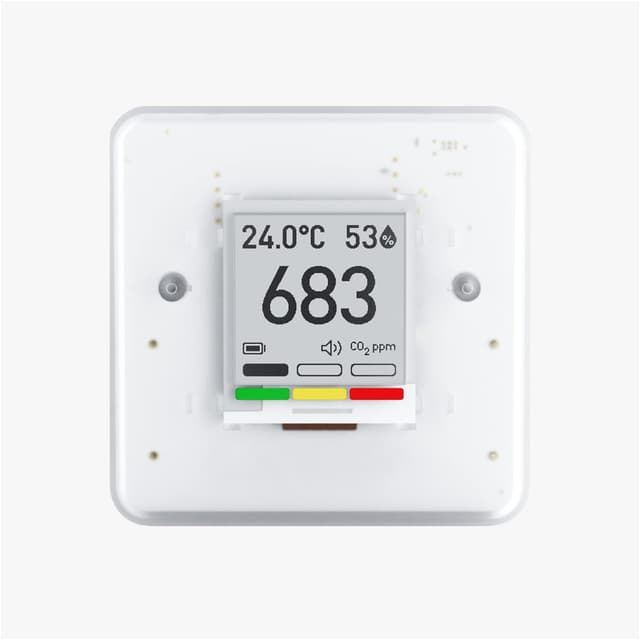Noah Brier | March 1, 2022
The Indoor Air Edition
On CO2, students, and ventilation
Recommended Products

Aranet4 Home is a smart, wireless indoor air quality monitor. It measures CO2 levels, temperature, relative humidity, and atmospheric pressure.
Noah here. A few weeks ago, I taught an in-person class to a room full of about 40 college students. The professor had told me that he’s noticed the students seem to start dropping off after about 45 minutes and that it’s important to make sure we do breaks around that time. Remembering my own time sitting in those chairs, I have lots of empathy for trying to stay focused in a classroom, but I also wondered whether it wasn’t something else that might be killing attention. Because I usually have my CO2 meter around, I thought it might be interesting to see what the levels look like as the students start to zone out. So I set up my computer and my Aranet4 monitor and got to talking.
CO2 reading from a plane trip yesterday. That’s not where you want to be.
Sure enough, right around 45 minutes, the CO2 levels in the room had broken 1,000 parts per million (ppm). So I gave everyone a break, popped open both doors for cross-ventilation, and kept my eyes on the CO2 level for the rest of the class.
Why is this interesting?
Ventilation and air quality have been big topics in my life for the last two years. What started as a way to understand COVID transmission has turned into quite a bit of reading and conversations about the air we breathe. In particular, I’ve become very interested in indoor carbon dioxide (CO2) both as a proxy for the ventilation of a space and also on how it affects our mental capacities.
The basics of CO2 are simple: there is a base outdoor level that tends to hover a little above 400 ppm. Since we exhale CO2, the indoor level above that number is a good indicator of how much outside air is flowing through. The closer the number is to the outdoor level, the more the air is being changed. On the flip side, if it’s significantly higher than outdoor levels, it means the air is stagnant, and you’re breathing in the exhales of others. If that breath contains viral particles, then there’s a good chance you’ll inhale some given enough time in the enclosed space.
Beyond the implications for COVID and other airborne viruses, which are well-covered at this point, there’s also a direct effect of CO2 on our brains. It seems to make us worse at thinking. While more research still needs to be done, multiple studies have shown cognitive declines as CO2 levels break 1,000 ppm. For example, the chart below from a paper by Harvard School of Public Health’s Healthy Buildings Programs director Joseph Allen and team, “found statistically significant declines in cognitive function scores when CO2 concentrations were increased to levels that are common in indoor spaces (approximately 950 ppm).” Things got even worse as CO2 levels surpassed 1,400 ppm.
Now think back to all the windowless class and conference rooms you’ve sat in for hours. Think about the moment an hour in when the air feels stale, and everyone seems to be a bit braindead. If it resembles one of the many poorly ventilated NYC meeting rooms I’ve occupied throughout my career, it wouldn’t be surprising if you were sitting in CO2 levels of 2,500 ppm. Beyond how gross it is that you’re breathing in lots of other people’s exhalations (at 1,200 ppm, you’re inhaling exhaled breath every 50th breath or so), those kinds of levels also mean everyone in the room is operating at a serious cognitive disadvantage. That’s probably pretty counterproductive if you’re having an important strategy meeting that requires the company’s best brains.
So what do you do about it? Start by opening up a door—two if you’ve got them. If there’s a window available, that’s even better. In just a few minutes, with a window open, you can bring a room at 1,200 ppm CO2 all the way back down to the 600-700 ppm range. There’s still lots more to learn in this area, but at least for me, I know I won’t walk into another conference room again without spotting the doors and the windows and thinking about how we can keep the air moving. (NRB)
--
WITI x McKinsey:
An ongoing partnership where we highlight interesting McKinsey research, writing, and data.
Your guide to CEO Excellence. What if the world’s highest-performing CEOs held a master class on the skills and practices that have driven their success? A new McKinsey book, CEO Excellence, is an insight-packed look at how the best CEOs do their jobs—including chiefs at JPMorgan Chase, Netflix, and Sony. Preorder it now.
—
Thanks for reading,
Noah (NRB) & Colin (CJN) &
—
Why is this interesting? is a daily email from Noah Brier & Colin Nagy (and friends!) about interesting things. If you’ve enjoyed this edition, please consider forwarding it to a friend. If you’re reading it for the first time, consider subscribing (it’s free!).


